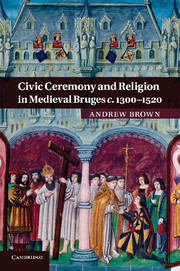Book contents
- Frontmatter
- Contents
- List of figures
- List of maps
- Acknowledgments
- List of abbreviations
- Note on currency and monies of account
- Introduction
- 1 The Holy Blood procession
- 2 General processions
- 3 Feast days and liturgical commemoration
- 4 Guilds: feast, festivity and public worship
- 5 Guilds and civic government
- 6 Civic charity
- 7 Civic ceremony, religion and the counts of Flanders
- Conclusion and epilogue: civic morality c. 1500
- Appendices
- Bibliography
- Index
3 - Feast days and liturgical commemoration
Published online by Cambridge University Press: 03 May 2011
- Frontmatter
- Contents
- List of figures
- List of maps
- Acknowledgments
- List of abbreviations
- Note on currency and monies of account
- Introduction
- 1 The Holy Blood procession
- 2 General processions
- 3 Feast days and liturgical commemoration
- 4 Guilds: feast, festivity and public worship
- 5 Guilds and civic government
- 6 Civic charity
- 7 Civic ceremony, religion and the counts of Flanders
- Conclusion and epilogue: civic morality c. 1500
- Appendices
- Bibliography
- Index
Summary
In 1419 the town magistrates decided to seek another kind of change to Holy Blood day. Liturgical arrangements for the feast day on which it fell – the Invention of the Holy Cross – were now thought insufficiently grand. In April they persuaded the clergy of St Donatian's to elevate the feast from a simple double to a triple, as Holy Trinity day was already then celebrated. Such was the ‘popular devotion’ for the Holy Blood procession, and so great the number of prelates who attended from Flanders and beyond, that the feast day required a higher rank. The town agreed to pay £24 parisis a year towards the more elaborate procedures required: the celebration of the offices of the day from first to second vespers, the singing of mass and motets, the hanging of gold and silk cloths on the high altar, lighting and bell-ringing, and pittances to the clergy who processed during the two weeks that followed Holy Blood day. To ensure that the new arrangements for the feast were remembered, they were copied into one of the town's cartularies.
This chapter is partly about the context in which such arrangements took place. At one level, the initiative of the town council in this matter is a striking example of the steps that civic bodies felt able to take in sacred affairs. It is one further way, besides management of processions, in which the magistracy sought to marshal the liturgical and sacred resources of the town.
- Type
- Chapter
- Information
- Civic Ceremony and Religion in Medieval Bruges c.1300–1520 , pp. 100 - 132Publisher: Cambridge University PressPrint publication year: 2011



